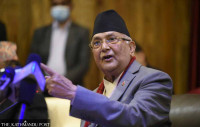Opinion
Nepal’s credit worthiness
The government is exploring options to have the country’s sovereign credit rating determined with the objective of borrowing funds from the international bond markets and creating a benchmark for foreign investors to evaluate investment risk.
The government is exploring options to have the country’s sovereign credit rating determined with the objective of borrowing funds from the international bond markets and creating a benchmark for foreign investors to evaluate investment risk. The government had wanted to obtain the sovereign credit rating ahead of next month’s investment summit, but it has given up on the idea for now as it takes months for rating agencies to initiate the analysis for the first time.
A good and stable sovereign credit rating indicates that Nepal’s macro economy is on a sound footing, the policies are credible and competitive, and that its institutional, political and governance regimes are trustworthy and predictable. This will eventually allow Nepal to access funding in the international capital markets, where it can borrow at reasonable rates to finance development spending. However, since Nepal is not yet rated and does not issue bonds in the international market, investors depend on alternative general country risk ratings done by specialised agencies that rely on analysis and the opinions of a network of economists and policy experts. Currently, Nepal’s external borrowing consists of loans from multilateral institutions and bilateral governments.
Current rating
Nepal will have to request one of the three large rating agencies—Standard & Poor’s, Moody’s and Fitch, which together command 95 percent of the rating business—to evaluate its economic and political situation to secure a sovereign credit rating. This is a measure of the country’s credit worthiness. A better rating means easier and cheaper participation in the international bond market, particularly when it wants to sell its medium and long-term bonds to raise capital. It assures the markets that the country will be able to make timely principal and interest payments without the likelihood of a debt default. Furthermore, a better rating gives confidence to foreign investors that the country’s political and economic situation is in good standing, which helps lower perceived investment risk.
According to a World Bank 2013 working paper on sovereign shadow rating of unrated countries, Nepal would have a rating of CCC with a positive outlook (Moody’s equivalent would be Caa1). In terms of the quality of rating, Nepal would fall under the high default risk category. This predicated shadow rating is based on estimates that control macroeconomic, structural and governance indicators, and is reflective of the period immediately following the global financial crisis. The main factors that contributed to the estimated rating were poor governance (as shown by the score in the rule of law indicator) and low public debt.
Things have changed since then; public debt, in particular, is rising as the government is borrowing more to finance post-earthquake reconstruction and other infrastructure projects. Furthermore, the latest governance indicators indicate that perceived corruption has also increased. Other indicators that are taken into consideration are per capita income (since a large tax base increases the government’s ability to repay debt), robust economic growth (debt servicing is easier as revenue also increases), low inflation, and import cover by foreign exchange reserves, among others. Considering the latest state of these macroeconomic as well as governance indicators, a downward revision from the estimated shadow rating in 2013 cannot be ruled out if the same exercise is carried out now.
Unfortunately, such estimates of shadow rating of unrated countries is not done frequently. For recent updates on a country’s investment risk, investors closely follow alternative ratings done by various risk rating and monitoring agencies, which rely on experts to evaluate a country’s economic, political, institutional, structural, and social development and outlook. For instance, Euromoney Country Risk (ECR) is one measure of rating based on the opinions of a global network of economists and policy analysts spanning over 186 countries. It is generally used as a live indicator of sovereign risk. Currently, Nepal ranks 135 (15 points up in ranking in the recent quarter) with a score of 31.89, which falls under the ECR Tier 5 category and corresponds to credit rating of D to B- (in other words, between high default risk and highly speculative). Countries in this category are highly reliant on external transfers (remittances and foreign aid), the economic and political situations are volatile, the state of infrastructure or structural characteristics is weak, access to capital and sovereign credit rating is pretty much nonexistent, and debt indicators are poor.
Convincing investors
Lowering the country risk premium is one of the ways to convince foreign investors about higher return on investment. For this, organising an investment summit and drumbeating the state of improved political regime and never-ending commitment to facilitate foreign investment alone are not going to be sufficient. It requires convincing experts and investors engaged in rating the economy about tangible changes in reducing political, exchange rate, economic and capital risks. This also means walking the talk by proactively highlighting tangible results, not only assurances or half-baked policy reform. For instance, the government is rushing to update or enact new investment related legislation ahead of the investment summit. This is a good start, but this should have been done months ago so that there is adequate homework in implementing the laws and in identifying operational bottlenecks. A case in point is the proposed fundamental amendment to the Special Economic Zone Act—dubbed as a milestone in spurring investment and exports—barely two years after it was approved. Changing consensus on assessment and outlook on the economic, political and social aspects of the country is very important for an upgrade in country risk ratings, which could result in a lower investment risk premium.
As for the sovereign credit rating, Nepal could approach one of the rating agencies for a shadow rating—an unofficial rating that can be used by the country to gauge how it is going to be perceived by the international bond market and potential investors. Nepal will informally know how its debt instruments will be priced, that is how much interest buyers will charge for debt issued by the country. If the shadow rating is not to our expectation, then we can put off a formal rating and issuing sovereign bonds. Importantly, it will give a good overview of the political, economic and institutional aspects that need to be improved to secure a good rating. Since downgrade periods are shorter and deeper than upgrade periods, it is good to initiate the rating exercise when economic, political and institutional fundamentals are strong.
Sapkota is an economist.




 8.12°C Kathmandu
8.12°C Kathmandu









